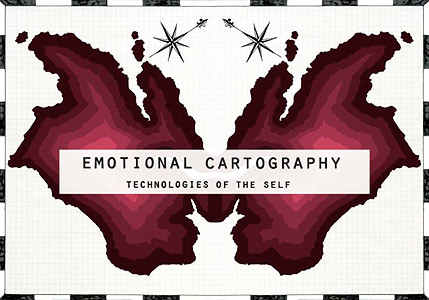Christian Nold (ed.): Emotional Cartography: Technologies of the Self (2009)
Filed under book | Tags: · biometrics, cartography, community art, data visualisation, hacking, mapping

Emotional Cartography is a collection of essays from artists, designers, psychogeographers, cultural researchers, futurologists and neuroscientists, brought together by Christian Nold, to explore the political, social and cultural implications of visualising intimate biometric data and emotional experiences using technology.
Edited by Christian Nold, 2009
Essays by Raqs Media Collective, Marcel van de Drift, Dr Stephen Boyd Davis, Rob van Kranenburg, Sophie Hope and Dr Tom Stafford
A5 Offset Litho – 96 pages – Full Colour
ISBN 978-0-9557623-1-4
Published under a Creative Commons, Attribution, NonCommercial, ShareAlike Licence
More info (author)
PDF (Full Quality PDF, 44 MB)
PDF (Screen Quality PDF, 2 MB)
MIT Comparative Media Studies student theses (2001-2008)
Filed under thesis | Tags: · cartography, curating, data visualisation, internet art, media culture, net art, politics
AMANDA FINKELBERG
Space, Place, and Database: Digital Cartography in the Network Age (2007)
This paper addresses the changes in cartography since digitization and widespread popular dissemination. Cybercartography, an emergent system of maps, mapmaking tools, and mapmakers, forces a rethinking of spatial representations. The implicit distinction in digital media enables a new type of map user or neo-geographer that creates layers of expressions based on subjective experience. This paper argues that the neogeographer signifies a new cartographic behavior that affords a complex subjectivity. This behavior is further exhibited in the practice of navigable maps and virtual globes which lead the way to a paradigmatic change in the way we represent and interact with space. It is divided into three parts: Part I addresses the role of digitization in maps and lays out framework and vocabulary. Part II examines layers of spatial representations in historical context. Part III opens room for future study in the quickly developing inhabitable cartographic spaces of virtual globes and virtual worlds.
PDF
KAREN VERSCHOOREN
.art: situating internet art in the modern museum (2007)
This thesis provides a critical analysis of the relation between Internet art and the traditional institution for contemporary art in the North American and West-European regions. Thirteen years after its inception as an art form, the Internet art world finds itself in a developmental stage and its relation to the traditional institution for contemporary art is accordingly. Through an elaborate discussion of the key players, institutions and discourses on aesthetics, economics and exhibition methodologies, this sociological analysis of the past and current situation hopes to offer a solid ground for extrapolation and predictions for Internet art’s future as an art world in its relation to the traditional art institutions.
PDF
STEPHANIE DAVENPORT
Experiments in Corporate Collaboration: The Case of the Ars Electronica FutureLab (2003)
PDF
SOPHIE ORMEROD
The Medium Still Isn’t the Message: Revisiting the Link Between Communication Technologies and Political Liberalization (2002)
PDF
Paul A. Fishwick (ed.): Aesthetic Computing (2006)
Filed under book | Tags: · aesthetics, computer art, computer graphics, data visualisation, information aesthetics

In Aesthetic Computing, key scholars and practitioners from art, design, computer science, and mathematics lay the foundations for a discipline that applies the theory and practice of art to computing. Aesthetic computing explores the way art and aesthetics can play a role in different areas of computer science. One of its goals is to modify computer science by the application of the wide range of definitions and categories normally associated with making art. For example, structures in computing might be represented using the style of Gaudi or the Bauhaus school. This goes beyond the usual definition of aesthetics in computing, which most often refers to the formal, abstract qualities of such structures—a beautiful proof, or an elegant diagram. The contributors to this book discuss the broader spectrum of aesthetics—from abstract qualities of symmetry and form to ideas of creative expression and pleasure—in the context of computer science. The assumption behind aesthetic computing is that the field of computing will be enriched if it embraces all of aesthetics. Human-computer interaction will benefit—”usability,” for example, could refer to improving a user’s emotional state—and new models of learning will emerge.
Aesthetic Computing approaches its subject from a variety of perspectives. After defining the field and placing it in its historical context, the book looks at art and design, mathematics and computing, and interface and interaction. Contributions range from essays on the art of visualization and “the poesy of programming” to discussions of the aesthetics of mathematics throughout history and transparency and reflectivity in interface design.
Contributors: James Alty, Olav W. Bertelsen, Jay David Bolter, Donna Cox, Stephan Diehl, Mark d’Inverno, Michele Emmer, Paul Fishwick, Monica Fleischmann, Ben Fry, Carsten Görg, Susanne Grabowski, Diane Gromala, Kenneth A. Huff, John Lee, Frederic Fol Leymarie, Michael Leyton, Jonas Löwgren, Roger F. Malina, Laurent Mignonneau, Frieder Nake, Ray Paton, Jane Prophet, Aaron Quigley, Casey Reas, Christa Sommerer, Wolfgang Strauss, Noam Tractinksy, Paul Vickers, Dror Zmiri
Published by MIT Press, 2006
ISBN 026206250X, 9780262062503
457 pages
Key terms: graph drawing, human-computer interaction, Christa Sommerer, Mixed Reality, mathematical beauty, computer science, Scientific Visualization, identity element, Ars Electronica, digital art, SIGGRAPH, information visualization, interaction design, computer graphics, Leonardo Journal, semiotic, aesthetic computing, series-parallel graph, Frieder Nake, Manfred Mohr
PDF (updated on 2012-10-13)
Comment (0)
